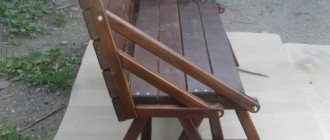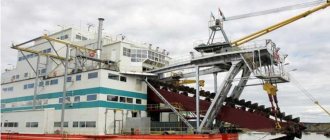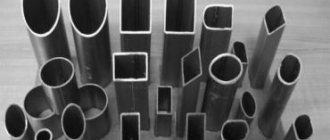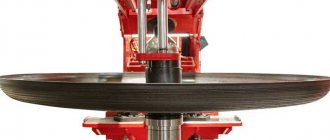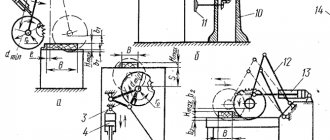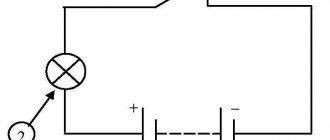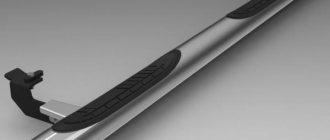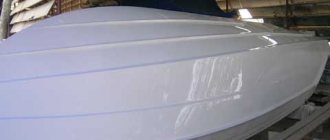Rolled metal in the form of profile pipes is widely used in private housing construction. It often has to be bent when making various structures. To do this, professionals use a pipe bender for profile pipes of various sections. Let's look at the special device in more detail and find out its application, classification, design features, existing varieties, and their advantages.
Device for bending a pipe profile Source hobbywork.ru
Stationary pipe bender: step-by-step instructions
If you plan to make your own greenhouse from steel pipes, then you will need to acquire not just an ordinary pipe bender, but a reliable product.
After all, with this approach you will need to bend more than a dozen profile pipes. To make the greenhouse design neat and beautiful, you need to use a stationary pipe bender. Before you start making a greenhouse, you need to make sure that you have the appropriate tool for bending profile products. The following elements will be needed to construct a stationary pipe bender:
- rod at 25;
- 6 bearings;
- channel.
You will also need a welding machine, which will be used to connect all the components. Step-by-step instructions for making a stationary pipe bender are as follows:
- Bearings are welded to the base (channel), which are connected to each other by a shaft in the form of a steel pipe of the appropriate diameter.
- To prevent the shaft from being located too close to the base, the bearings should be welded onto 5 cm pieces of rectangular pipe.
- In order to deliberately produce a unit with which the bending radius could be adjusted, the base must be made of two channels connected to each other by curtains, as can be seen in the photo above.
- Two shafts with bearings are located at the same height, and the third (central) is welded using a rectangular tube 15-20 cm higher.
- An additional tube needs to be welded to the upper shaft, to which the handle will be attached. This shaft will be driven by muscular force.
- The handle is welded to the upper shaft, after which the resulting product can be checked for functionality.
When installing a profile tube of any size, you should adjust the radius of the final bend. This can be done using a jack located under the base on which one of the shafts is fixed. Having adjusted the required bending radius, the handle rotates. The result is high-quality curved tubes. The advantage of a pipe bender is the ability to bend materials of any size and diameter.
Among the disadvantages, we can only note the possibility of operation in one place
It is important to understand that such a device can be used for any need. To manufacture such a device, an investment of no more than 500 rubles will be required.
You only need to buy 6 bearings, and all the other elements can be found in every craftsman’s household.
Artgold LLC (Ufa) - equipment for artistic forging - forging, welding, blacksmithing
Home page » Companies » LLC Artgold (Ufa) – equipment for artistic forging
The Artgold company provides a wide range of creative solutions for interior and exterior. The company also produces and sells equipment for artistic forging. The production of machines is carried out on certified, high-quality and modern installations. When manufacturing machines, all customer requirements and wishes are taken into account.
Forging equipment allows you to create a variety of forged products. The performance and precision of the machines guarantees the implementation of complex and large projects. The company's customers are located in all regions of Russia, as well as in the CIS countries. Delivery is carried out by a transport company.
Artgold LLC is located at:
- Ufa, st. Kirovogradskaya, 33, hall 1, department 52 B.
- Oktyabrsky, Ostrovsky str. 6/B, 2nd floor, Orbita shopping center.
- Telephones in Ufa - a single information desk; 8 (987) 254-74-73 – Leah; - Andrey.
- Email –;
- Website – https://artgold3d.ru/.
- Machines for artistic forging:
- Electrically driven houndstooth and snail.
- Manual machine for making baskets.
- Machines for artistic forging: houndstooth, snail, twister, pipe bender.
- Electric goose foot machine.
- Machine for forging a goose foot and reinforcing a profile pipe with 10*10 balls; 15*15; 20*20.
- Machine for forging goose foot, manual.
- Snail forging machine with electric drive 220/380.
- Machine for rolling profile pipes with 10*10 balls; 15*15; 20*20.
- Machine for rolling profile pipes with 10*10 balls; 15*15; 20*20, electric.
- Machine for rolling clamps for closing welding seams.
- Machine for cold rolling of profile pipes from 10*10 to 25*25.
- Machine for cold rolling of profile pipes, profile 10.15.20.
- Cold forging machine: snail, twistor, pipe bender, basket.
- Pipe bender for profile pipe with jack 40*40.
- Pipe bender for profile pipes with electric drive 220/380.
- Slava for rolling pipes on a plane with 10*10 balls; 15*15; 20*20; 40*20, electric.
Company in the section(s) offering:
Pipe benders - design and types
If to manufacture a structure it is necessary to bend a profile pipe along a radius, then a pipe bender can easily cope with this, with which you can make a bend up to an angle of 180 degrees. This device is capable of changing the configuration of pipes made of stainless steel, metal-plastic, and aluminum. In this case, the bending is carried out according to the required dimensions and shape.
Pipe bender design
The design of such a tool depends on its type. However, the required elements are:
- hydraulic cylinder - the main part of the machine that performs the power function;
- open or closed frame;
- two pipe stops;
- lower and upper bars;
- injection device, handle and bypass valve located on the rear of the structure body;
- retractable rod, which provides the bending force of the pipe bender;
- a spring with the help of which the retractable rod returns back;
- a trunnion or stop of a structure, the ends of which are inserted into holes in the slats.
On top of the main part of the machine there can be a level check and an oil fill plug. Installation strips, which are a welded structure, are screwed onto the threaded part of the tool. The bottom bar is secured with a locking nut, and the top bar is pressed with two screws and a lock.
To install supports, special holes are provided on the transverse plates of the device. The bottom of the pipe bender has threaded holes for mounting bolts that are height adjustable.
The bent pipe on such a structure is located on a stream, which is located in the middle of its stop. The bending segments must be made of precision cast steel.
Today, thin-walled profile pipes with thin walls are increasingly used for the manufacture of various structures. Therefore, the design drawing of a pipe bender for such workpieces is somewhat different. To prevent deformation of its cross-section when bending the pipe, profile rollers should be selected with the same cross-section as the product.
Types of pipe benders
Commercially available professional pipe benders can be manual, electric or hydraulic driven.
Electromechanical tools are considered the most convenient
The manual drive design is used for bending small diameter pipes.
Hydraulically driven pipe benders are capable of bending workpieces that can be up to three inches in diameter. Therefore, such a tool is designed to perform large-scale work.
In addition, pipe benders may differ in the way they influence the product, with the help of which it will be bent. These methods include:
- Crossbow method, in which the pipe rests on two stationary rollers and bends between stops under the influence of a template located on the rod.
- Winding - with this method of bending, the workpiece first attaches itself to the roller of the structure. Then a stop is placed at the bending point. The roller begins to rotate and wind the pipe between itself and the stop. In this case, the template and the product are movable.
- Rolling is the simplest way to bend a pipe. On such a device the template is motionless. The pipe is simply clamped and the pressure roller moves and bends the pipe around the template.
- The rolling or rolling method involves the use of three rotating rollers. One of them is central, and two are supporting. The central roller presses on the workpiece, so it must be installed relative to the supporting elements in accordance with the required radius of the product.
pressure from the rod is transferred to the workpiece at the top point of the template
The rolling method has virtually no disadvantages. It is by rolling that steel bends are manufactured in the factory. Using the same method, it is much easier and more efficient to bend profile pipes.
Hydraulic roll forming machines
Hydraulic roll bending mechanisms allow efficient bending of pipe assortments with complex profiles. When using such equipment, the specialist makes minimal physical effort, because the main actions are performed by the hydraulic system.
A bending device with hydraulics for corrugated pipes is a more advanced mechanism than a manual profile bender. The equipment is equipped with wolves for horizontal and vertical rolling of workpieces. This allows you to bend the rolled product in several directions at various required angles and required radii in one operation.
A standard machine with hydraulics for bending profile pipes is equipped with 3 rollers. One of them is pressure rollers, and the other two are drive rollers. For their manufacture, manufacturers use durable alloy steel. For this reason, rollers rarely have to be replaced with new rollers. If necessary, they can be easily removed from the hydraulic machine, which allows for quick service work.
Classification of pipe bending devices
Devices for bending steel pipes are classified:
- by degree of mobility (stationary and portable);
- by type of drive (manual, electric, hydraulic, electrohydraulic);
- according to the method of influence (running in (roller), winding, impact with a rod (crossbow), rolling).
The essence of how a pipe bender influences a pipe is as follows.
Run-in
With this method, one end of the pipe is clamped, and a stationary template is used to give it the required bend. Pressure rollers are used to roll the product around the template.
Drawings of a rolling pipe bender
Winding
In such a device, the pipe is pressed against a movable template (roller), on which it is wound, stretching between a rotating roller and a special stop installed at the beginning of the bending point.
Diagram of a pipe bender operating on the winding principle
Crossbow pipe benders
In such a pipe bender, the pipe rests on two stationary rollers, and bending is performed by a template, which is attached to a movable rod. The template presses on the middle of the fixed section of the pipe, thereby giving it the required bending angle.
Diagram of a crossbow pipe bender: 2 - jack, 3 - shoe (punch)
Rolling or rolling
The required bending radius is obtained using a three-roll device, the basis of which is two support rollers and one central roller. The central roller exerts pressure on the pipe, the position of which determines the radius of its bend. is more universal; in all other machines the bending radius depends on the template used.
Compact size manual rolling pipe bender
The manufacture of a pipe bender operating on the winding principle is not simple, so such a device is made mainly in an industrial way. The crossbow method has another significant drawback: the pressure from the rod with a template attached to it, called a shoe, is concentrated in its upper part. This method of acting on the pipe leads to its significant stretching along the outer radius of the bend, which may be accompanied by a decrease in wall thickness and even its rupture. It is especially not recommended to use the crossbow method for bending thin-walled products.
An example of a homemade rolling (rolling) type pipe bender
A machine operating on the principle of rolling (rolling) practically does not have all of the above-mentioned disadvantages; this technology is used in the production of bends in the factory.
A DIY pipe bending machine can have a different design. You should choose its type based on what radius you need. There is a list of recommendations, in accordance with which the choice of a specific model of device for bending steel pipes is made. Important parameters that need to be taken into account are the thickness of the pipe walls and its overall diameter. Before starting to work with a pipe bender, it would not hurt to familiarize yourself with the data in the table showing the maximum possible radii for bending steel pipes.
Dependence of the bending radius on the diameter and wall thickness of the pipe
To obtain a bend radius smaller than that specified in such recommendations, it is necessary to use hot rolling, which is used mainly in production conditions. A device with a mandrel is more difficult to create at home, so they are much less likely to be made independently, giving preference to rolling ones.
In order to independently hot-roll a pipe, you can resort to using a home-made pipe bender, but provided that it is made entirely of metal and its frame is highly reliable. To perform such a technological operation, you will additionally need a blowtorch or gas burner.
Electric profile benders
Manufacturers also equip equipment for bending corrugated pipes with an electric drive. This machine for a profile pipe is a professional device that allows you to bend the workpiece as accurately as possible in accordance with the given dimensions. Electric profile bending machines are used by specialized companies for the serial production of bent parts of metal structures. Its customizable rollers are designed for bending metal products, which can be made from various steel, copper, aluminum alloys and so on.
High-quality steel is used in the manufacture of electric pipe benders. Rolling rollers are made from it. They are highly wear resistant. Therefore, they do not have to be replaced frequently with new parts.
Electric pipe benders for corrugated pipes are not mobile devices. They are stationary equipment. For their operation, a constant connection to the electrical network is required. Such machines are installed in production shops and forging plants.
How to build a hydraulic pipe bender
The design of a hydraulic pipe bender with your own hands is presented in the video below.
Building a tool of this type will not be difficult if you have two 0.5 meter channels at your disposal. The base of such a device included the following elements:
- hydraulic cylinder;
- stops;
- supercharger.
In addition, you should also highlight:
- A jack that can withstand loads of up to 5 tons.
- There are 2-3 rollers.
- Channel - 3-4 mm.
- Thick plates.
The principle of using such a tool is that you need to install a profiled pipe into the shoe. Use a jack to set the required bending radius. When the jack is inflated, the rod rises, pressing on the roller. After establishing the bending angle, the pipe can be removed. This type of bending device is relevant when it is necessary to bend a pipe in one place, for example, when installing a heating system.
What is the unit for?
To bend a profile pipe, you do not need to turn to a metal shop for help or buy a special tool. This can be done using two metal posts buried in the ground. However, this method has a significant drawback - the need for physical effort. The result is an inaccurately curved pipe, which is not suitable for constructing a greenhouse, arch or other products.
A pipe bender is designed to be able to produce neatly curved pipe shapes. These units are subsequently used for the construction of arches, greenhouses, ceilings, gazebos, fences, etc. If you set out to build a greenhouse at home, then you need to design a homemade pipe bender. If there are available products and tools for this, then implementing the design of the device with your own hands will not be difficult.
To make a roller pipe bender with your own hands for a profile pipe, you need to take care of the drawings. They are used to calculate the required amount of material, as well as the costs of producing a home-made unit.
The planned design of the product is applied to the drawing, which depends on the materials available.
Most craftsmen choose to manufacture front-type pipe bending machines. Such products consist of the following components:
- Rollers presented in the form of a round steel pipe (the number of required rollers is 3 pieces).
- Chain driving shafts.
- Axes of rotation.
- The mechanism that drives the device.
- Profiles that are used to make a base or frame.
It is worth noting that there are a huge number of manufacturing options for the products in question, but they all operate on the principle of rolling or rolling. It is this principle of pipe bending that makes it possible to reduce the risk of pipe bending and cracking.
A simple pipe bender has the form of a unit into which a profile pipe is inserted, after which the handle is turned, when rotated the pipe begins to move and a bend is formed
When constructing a home-made unit at home, it is important to consider that the bending parameters will depend on the design itself. The closer the pressure rollers are to each other, the smaller the angle. This is interesting: How to make a chicken coop for laying hens: let’s look into it in detail
This is interesting: How to make a chicken coop for laying hens: let’s look into it in detail
Video description
The operation of an electric stationary profile bender is shown in the following video:
One of the main advantages of electric profile benders is the minimum physical effort of the master, even when performing a large amount of work. The only exception may be the installation of workpieces and the acceptance of curved parts.
Electrically driven pipe benders make it possible to produce bent metal products of high quality. Manufacturers produce models in which the bending angle is adjusted manually or using special programs. The second version of the equipment is equipped with a remote or built-in display. It is designed to monitor ongoing operations on an electric profile bending machine.
You may like
VK comments:
Name *
A comment
- https://derevyannie-doma.com/tehnologii/trubogib-svoimi-rukami-chertezhi-kak-sdelat-ruchnoy-trubogib-dlya-profil-noy-truby.html
- https://obustroen.ru/instrumenty-i-oborudovanie/ruchnoy-istrument/slesarno-montaghnyy/trubogib-svoimi-rukami-chertezhi.html
- https://prorab.guru/insrtrument/trubogib-dlya-profilnyih-trub-svoimi-rukami.html
- https://obinstrumente.ru/ruchnoj-instrument/trubogib-dlya-profilnoj-truby-svoimi-rukami.html
- https://stroychik.ru/tools/trubogib-dlya-profilnoj-truby-svoimi-rukami
- https://sdelajrukami.ru/trubogib-svoimi-rukami/
- https://v-teplo.ru/trubogib-dlya-profilnyih-trub-svoimi-rukami.html
Do-it-yourself manual pipe bender for profile pipes
To bend a profile pipe with small cross-sectional dimensions without a pipe bender, craftsmen use templates of the desired curvature made of metal or wood. The workpiece is pressed manually to the edges of the segment, rigidly fixing one end.
Wood template
The thin-walled element can be deformed when heated. Heat the area with a blowtorch to a temperature of 350-400°C and, using manual force, give the profile an arched shape.
If using simple methods is not allowed by the product parameters, you can design a manual roller pipe bender for a profile pipe. It is used to make arches and arcs for canopies, greenhouses and other structures of complex shape.
Required materials and tools
To make the device, you will need:
- channel No. 8 or No. 10 for a rigid frame;
- 2 hardened steel rollers with steps for profiles of different heights or restrictive rings;
- roller with notches for the movable shaft;
- finished bearing units;
- 2 or 3 gears or sprockets;
- steel chain;
- clamping screw;
- thin pipe for the gate;
- lever;
- welding machine;
- drill;
- "Bulgarian";
- hammer.
You also need cotter pins, nuts, threaded bushings, and washers. To process the finished structure you will need paint and lubricant.
Blueprints
The drawing is the basis that will help you make a pipe bender without making major mistakes.
This is especially important when working with metal labor-intensively.
Ready-made drawings are available on the Internet. Having sufficient experience, they are easy to understand and adapt to your capabilities.
You can imagine an approximate structure of a pipe bender by studying a factory analogue, and then develop a detailed diagram of your model.
Drawing and general view of a hand tool
Construction assembly stages
Sequence of operations for making a homemade roller pipe bender:
- Cut the channel to the dimensions of the posts and base.
- Drill holes in the frame parts to mount the rollers.
- Weld a support frame with racks from a channel.
- Cut and weld a housing from the channel with holes for installing the drive roller. The shaft should rotate easily inside.
- Secure the clamping screw to the resulting box using bearings. Drill a hole in the top of the screw for the collar.
- Insert the housing with the drive roller between the posts. The structure must move freely vertically. Secure the cover with a screw nut on top.
- Screw the bearing units to the frame.
- Insert the collar into the hole in the clamping bolt.
- On the outside of the shaft axis, place the gears on a key or split cone bushings with nuts. Attach the third “star” to the stand. Put on the chain and press in the sleeve for the handle.
- Conduct trial tests and make adjustments if necessary.
The last step is to disassemble, clean the metal from burrs, paint the fixed parts, and reassemble. Units that are subject to friction during operation should be treated with Lithol or other thick lubricant.
Ready homemade machine
To bend the workpiece, it is placed on stationary rollers, the pressure screw is lowered all the way and pulled using a rotating handle alternately in one direction and the other.
After each rental, the screw is tightened with a collar. When the arc acquires sufficient curvature, the screw nut is secured with a lock nut. This will allow you to bend several arches with the same radius.
This homemade pipe bender can even be used for professional purposes. It can handle profiles up to 60x60 mm in size or 3 pipes with a cross-sectional width of 20 mm at the same time.
Details of the handloom manufacturing process can be seen here
https://youtube.com/watch?v=W3SXjpAF1GM
Design of a homemade rolling machine
To roll a profile pipe, you need to make a simple device that will implement the following ideas:
- the pipe moves between guide bearings installed with a small gap (0.2...0.4 mm);
- Profiling rollers will press on it from above and below. When pushing the workpiece between them, the upper and lower edges will collapse. The side edges will not change.
Rolling machine for profiling pipes 20·20 mm: 1 – stand; 2 – body-cover; 3 – rolling roller; 4 – bearing
Between the upper and lower housing-covers 2, bearings 4 are located on special axes. The distance is chosen so that with a small gap the profile pipe can pass between them.
Rolling is carried out by two rollers 3 mounted on special stands 1. They are welded to the housings so that the rollers crush the pipe by 2.0...2.5 mm on each side.
The body-cover is made of a 6 mm thick plate
The roller must be made of high-strength structural steel. 65G spring steel can be used
There is no need to use expensive material to make the stand. Regular quality steel will do
The design provides for the use of a handle to rotate the roller. Similar handles are used on washing machines produced in the eighties and nineties of the last century. They can be found at metal depots and scrap metal collection sites.
Top 5 best manual pipe benders for profile pipes
Hand tools for bending profiles can be either mechanical or hydraulic. But both types of models are easy to use, moderate in cost and reliable.
Stalex HTR-40
A universal pipe bender for steel profiles with adjustable rollers allows you to roll workpieces with a diameter of 15-40 mm and a wall thickness of 1.5 mm. The bending radius can be changed quickly and easily during the process. The manual machine is equipped with hydraulics with a lifting capacity of 2 tons, there are return springs that bring the pressure roller back to the upper position without effort on the part of the user.
A compact and powerful pipe bender is suitable for making railings, canopies, canopies and other structures that use profile pipes. Since the machine is operated manually, it can be used anywhere, regardless of the availability of electricity.
You can buy a pipe bender HTR-40 from 16,000 rubles
Proma KO-200
The machine is designed for cold bending of steel rods, profile pipes and metal strips; it works with medium-hard materials. Equipped with a wide base for greater stability, it can also be mounted on a workbench using four holes. It is lightweight and small in size, making it easy to transport. Suitable for processing square and round pipes, the maximum bending angle is 200°.
You can buy a Proma profile pipe bender from 13,000 rubles
Stalex TR-60
A manual pipe bender with an extended working lever allows you to easily give the desired bend to metal workpieces with minimal force. The body is equipped with a ruler to control the deformation radius; the machine works with square and round pipes of 15-38 mm. Made of powder coated steel, suitable for stationary and tabletop installation.
Important! The disadvantage of the model can be considered the lack of rollers for working with profile pipes in the kit. However, they can be purchased separately. The average price of Stalex TR-60 starts from 16,000 rubles
Blacksmith MTB10-40
A manual pipe bender without an electric drive or hydraulics, however, is simple and reliable. The machine is equipped with three rollers - between them you need to clamp the workpiece and turn the handle to accurately bend the pipe. The angle is adjusted using the upper roller; it is pressed harder or weaker.
The effort required from the user is minimal; the budget machine is very functional and easy to use. The only negative is that in the absence of experience, controlling the flexion angle may cause difficulties.
The average cost of MTB10-40 starts from 14,000 rubles
Smart & Solid BendMax-300
The manual profile bender is designed to work with 50/30/2 mm pipes. The machine is made of durable steel with a two-layer zinc coating and is reliably protected from corrosion. Among the advantages are reliability, high-quality assembly and ease of operation. The tool can be used both at home and in small workshops.
You can purchase a bender for profile pipes BendMax-300 from 18,000 rubles
Video description
See the video for operating features of a hydraulic pipe bender.
Hydraulic profile benders are also equipped with three grooves, but they allow you to work with pipes of a larger cross-section. Its maximum dimensions can be 60*30 mm. Moreover, most models are capable of bending square pipes with a maximum cross-sectional size of 40*40 mm. A hydraulic machine for bending profiled pipes also allows you to bend rods, strips and round pipes.
The presence of an engine braking device increases the ease of use of pipe bending equipment with hydraulics. It allows you to stop the machine if adjustments need to be made. After this, the process can be continued further using the same workpiece. In addition, machines of this type are variable units. In other words, the devices can be manual, semi-automatic and fully automatic devices for bending corrugated steel pipes.
How to mechanize the process
Since the hydraulic drive has the greatest autonomy, in most cases it is used. As a source of generated pressure at home, you can use a conventional hydraulic jack. It is installed on top of the movable roller of the pipe bender and under the mandrel. By moving the jack handle, the necessary bending pressure is created.
The choice of standard size of a jack for a pipe bender depends on the plasticity limit of the workpiece material:
- For steels of type St3, steel 10 – 120...130 MPa;
- For steels of type St.5, steel 20 – 130...150 MPa;
- For brass – 80…100 MPa;
- For aluminum - 60...80 MPa.
When choosing a standard size, the stroke of the rod is also taken into account, which cannot be less than 115....120% of the final height of the curved pipe (inevitable springing is taken into account)
How to make a pipe bender with a pressure roller?
The material for the base of such a pipe bender is selected depending on the expected loads. Therefore, to make it, thick plywood or a sheet of metal is taken.
The holder for the pressure and central roller (template) can be made from a U-shaped metal blank. It should rotate freely around the central roller attached to the base. A lever in the form of a long handle is attached to the holder, and a stop is attached to the base.
For small workpieces, you can make a pressure pipe bender with your own hands for two different bending radii. To do this, the template must be made with rounded corners, each of which must have its own radius. The handle of such a tool should have two holes with which it can be removed and installed in another place.
Winding type pipe benders
Examples of such devices are hydraulic pipe benders, which are used to bend round pipes. The design of such a device has a powerful pulley to which the pipe is attached at the bending point. This pulley is fixed on a reliable frame, and at its base there is a rod, which is driven by a jack. A significant force is created on the rod using a jack, which is transmitted to a lever that rotates the pulley and winds the pipe onto it. The lever can rotate freely around the axis of the pulley and is connected to it using holes located around its circumference.
A working example of such a pipe bender can be seen in the video below:
You can also make a similar mechanical pipe bender yourself using a rack-and-pinion jack. More physical effort is required when using this device.
Example of work on video:
Examples of devices of this type include homemade pipe benders, the rollers of which are made of wood. When working with such devices for bending round pipes, it is necessary to apply significant physical effort, which is reduced by a movable rotating roller.
An example in the video below:
